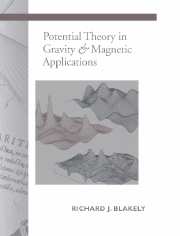Book contents
- Frontmatter
- Contents
- Introduction
- 1 The Potential
- 2 Consequences of the Potential
- 3 Newtonian Potential
- 4 Magnetic Potential
- 5 Magnetization
- 6 Spherical Harmonic Analysis
- 7 Regional Gravity Fields
- 8 The Geomagnetic Field
- 9 Forward Method
- 10 Inverse Method
- 11 Fourier-Domain Modeling
- 12 Transformations
- Appendix A Review of Vector Calculus
- Appendix B Subroutines
- Appendix C Review of Sampling Theory
- Appendix D Conversion of Units
- Bibliography
- Index
Introduction
Published online by Cambridge University Press: 10 October 2009
- Frontmatter
- Contents
- Introduction
- 1 The Potential
- 2 Consequences of the Potential
- 3 Newtonian Potential
- 4 Magnetic Potential
- 5 Magnetization
- 6 Spherical Harmonic Analysis
- 7 Regional Gravity Fields
- 8 The Geomagnetic Field
- 9 Forward Method
- 10 Inverse Method
- 11 Fourier-Domain Modeling
- 12 Transformations
- Appendix A Review of Vector Calculus
- Appendix B Subroutines
- Appendix C Review of Sampling Theory
- Appendix D Conversion of Units
- Bibliography
- Index
Summary
Though this be madness, yet there is method in't.
(William Shakespeare)I think I did pretty well, considering I started out with nothing but a bunch of blank paper.
(Steve Martin)Pierre Simon, Marquis de Laplace, showed in 1782 that Newtonian potential obeys a simple differential equation. Laplace's equation, as it now is called, arguably has become the most universal differential equation in the physical sciences because of the wide range of phenomena that it describes. The theory of the potential spawned by Laplace's equation is the subject of this book, but with particular emphasis on the application of this theory to gravity and magnetic fields of the earth and in the context of geologic and geophysical investigations.
A Brief History of Magnetic and Gravity Methods
The geomagnetic field must surely rank as the longest studied of all the geophysical properties of the earth. Curiosity about the mutual attraction of lodestones can be traced back at least to the time of Thales, a philosopher of ancient Greece in the sixth century B.C. (Needham). The tendency of lodestones to align preferentially in certain directions was known in China by the first century A.D., and perhaps as early as the second century B.C. This apparently was the first recognition that the earth is associated with a property that affects magnetic objects, thus paving the way for the advent of the magnetic compass in China and observations of magnetic declination.
The compass arrived in Europe much later, probably late in the twelfth century A.D., but significant discoveries were to follow. Petrus Peregrinus, a scholar of thirteenth-century Italy, performed several important experiments on spherical pieces of lodestone.
- Type
- Chapter
- Information
- Potential Theory in Gravity and Magnetic Applications , pp. xiii - xxPublisher: Cambridge University PressPrint publication year: 1995



